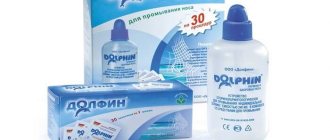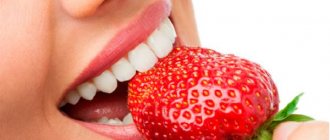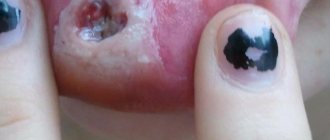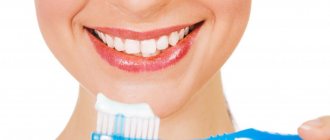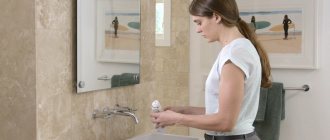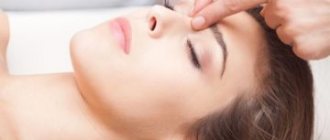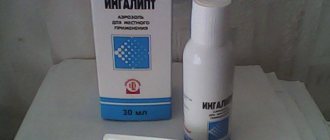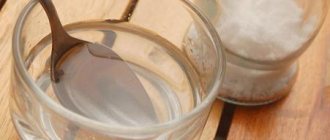A brush, floss or balm is not enough to completely clean your mouth of food debris. An irrigator is suitable for this - a device that removes plaque from the teeth and between them with a stream of water with pulsation. Let's find out what the features of this device are, why everyone needs it and how to choose it.
An irrigator designed for cleaning the oral cavity consists of a thin tube with a handle and a reservoir with liquid. It runs on mains power or batteries. A thin stream of water is fed through the tube, washing away food debris from the teeth and the spaces between them. At the same time, a light massage of the gums is carried out. The first irrigator was created in 1962. Since then, scientists have conducted more than 50 studies of these devices and almost every one of them has proven effectiveness.
In this article
- Who needs an irrigator
- Which oral irrigator to choose
- How to choose a nozzle for an irrigator
- Which balm to choose for an irrigator
- How to use an oral irrigator
- Which dental irrigator to choose
- Caring for your dental irrigator
Today, many similar devices are produced with different attachments and power. According to researchers, treating teeth with an irrigator with average settings for three seconds removes almost 99.9% of plaque from one tooth. In developed countries, the use of these devices has become a habit. In Russia they are not yet used so often. This is due to the fact that many do not understand the principle of their operation. We'll tell you how to choose an oral irrigator, who it's suitable for and how to use it.
Who needs an irrigator
This device is absolutely safe and does not harm gums and enamel, it can be used by all people. However, it does not replace a regular brush for daily dental care, so it is used as an additional means of maintaining oral hygiene. The irrigator is especially useful for people who wear braces, crowns or dentures. It is difficult to fully clean them with a toothbrush or by rinsing, but it is possible with the help of a directed jet of the device.
Regular use of the device helps prevent:
- Caries. The irrigator removes plaque on molars, in interdental spaces and around braces, preventing the decomposition of food and the spread of bacteria.
- Gum diseases. A pulsating jet of water massages, stimulates blood flow and promotes rapid tissue regeneration. As a result of systematic use of the irrigator, gum bleeding is reduced.
- Periodontitis is inflammation of the tissues surrounding the tooth. Pathology becomes a consequence of the spread of microbes. Using an irrigator, dental plaques, which are often the primary source of bacteria, are effectively eliminated.
Also, using an irrigator can eliminate bad breath. Regular use of the device prevents this problem from occurring.
You should not use an irrigator if there are inflammations or acute infections in your mouth. Also, such cleaning is contraindicated during exacerbation of chronic dental pathologies. Consult your dentist before using the device.
Nasal irrigator - the effectiveness of using a nasal rinsing device
Many people already know about the existence of an oral irrigator. It greatly simplifies and increases the efficiency of caring for teeth and gums.
But many people are hearing for the first time that there is an absolutely similar device for cleaning the nose and paranasal sinuses.
Using an irrigator to rinse the nose, in turn, helps to cope with a large number of ENT diseases, as well as perform the necessary hygiene, removing all dust, allergens and pathogens from the mucous membrane.
Using a nasal irrigator helps cope with nasal diseases
What is a nasal irrigator?
A nasal irrigator is a device designed to cleanse the nasal passages and sinuses of mucus, while simultaneously removing dust, chemicals and pathogenic organisms trapped inside on hairs.
Depending on the version, it may have certain design features, but its main parts are a container for liquid that washes the nasal cavity and a nozzle, which is designed to supply liquid directly into the nasal passage.
The main indications for using a nasal irrigator are:
- prevention of inflammatory diseases of the nose and paranasal sinuses;
- epidemiological preventive measures;
- prevention of allergic rhinitis;
- prevention of adenoids;
- prevention of the nasal mucosa in dusty conditions.
But, just like any other method of rinsing the nose, using an irrigator has a number of contraindications, the main of which include:
- inflammatory process in the inner ear or acute otitis media;
- increased frequency of nosebleeds;
- absolute obstruction of the nasal passages. In this case, before using the device, it is necessary to drip vasoconstrictor drops into the nose, which will ensure the ability to breathe through the nose;
- neoplasms in the nose.
Increased frequency of nosebleeds is a contraindication for the use of an irrigator
In addition, according to experts from the American College, whose main activity is the study of immunology, asthma and allergies, constant nasal rinsing can cause negative consequences even in people who have no contraindications for performing this procedure.
So, based on the research, they were able to conclude that constant rinsing of the nasal sinuses and clearing mucus from them leads not only to the removal of harmful bacteria from the nasal passages, but also beneficial antifungal, antibacterial and antiviral agents.
The consequence of this may be a more frequent occurrence of sinusitis in humans.
But since the saline solution, which is most often used as a rinsing liquid, is not harmful in itself, this procedure can and should be performed during the treatment process, but the duration of such a course should not exceed 2-3 weeks.
Today, on the consumer market, this device is presented both as an independent mechanical device and as an additional function in other electrical devices, namely:
- aspirator;
- inhaler;
- Oral irrigator.
Each of them has its own characteristics in design and method of application. The result of use is identical - mucus and all foreign particles and microorganisms are washed out of the nose.
Mechanical nasal irrigator
An independent device for rinsing the nose is a plastic flask with a special nozzle, a lid with a tube and a valve. The device comes with two types of attachments, intended for use by adults or children. The way to use it is as follows:
- A solution for rinsing the nose is poured into a plastic flask. It can also be replaced with a composition prepared from 300 ml of purified warm water and 2.7 grams of sea salt;
- an age-appropriate nozzle is put on the irrigator;
- the torso leans forward and the head slightly to the side;
- The irrigator nozzle is inserted into the nasal opening located on top, while holding the flask upside down, after which the valve is pressed;
- after that the procedure is repeated in the same order for the other nasal opening.
Mechanical nasal irrigator
At the moment when the irrigator nozzle is inside the new hole and the solution flows out of it, breathing should be done only through the mouth. In this case, the liquid will, passing and washing the maxillary sinus, flow out of the other nasal opening. All mucus will be removed from the nose along with the fluid.
In addition to saline solution, decoctions of medicinal plants such as chamomile, St. John's wort, calendula or string are suitable for rinsing the nose with such an irrigator. But they can only be used if a person has never had an allergic reaction to these components.
In case of allergic rhinitis, regardless of the factor that provokes it, the use of decoctions of medicinal plants for rinsing the nose is unacceptable.
Also, to prepare a composition for use in an irrigator, you can use furatsilin tablets, which are first thoroughly diluted in warm boiled water.
Furacilin solution is suitable for nasal irrigator
Irrigator in aspirator
The principle of joint operation of the irrigator and aspirator is to irrigate the nasal cavity with liquid and then remove it.
In this case, the irrigator sprays liquid poured into one of the device’s containers with a thin stream, ensuring cleaning of even the most inaccessible places, and the aspirator, after changing the nozzle, sucks it into another container.
To provide the ability to select the intensity of the liquid jet, there is a special regulator on the device body. Therefore, this device can be used by both adults and children.
The operation of such irrigators can be performed either from an electric current network or from rechargeable batteries, which must be periodically charged.
All containers, hoses and nozzles can be separated from each other and boiled, providing the necessary disinfection and keeping the device perfectly clean.
In addition to choosing the power, using the irrigator in accordance with age should be done with the appropriate nozzle.
Aspirator-irrigator
Irrigator in inhaler
An inhaler is a device designed to spray medications in the form of a fine aerosol. This transformation is achieved by exposing the liquid to a sufficiently powerful air flow generated by the compressor through a small hole in the nozzle.
In most cases, the use of an inhaler is necessary to treat the lower and upper respiratory tract. In order for such a device to be used as an irrigator, the nozzle on it is changed.
At the same time, the capacity of the liquid that it contains increases in volume and with it the hole for air supply.
Unlike an aspirator, this device will not remove mucus from the nose.
This version of the device is more similar to a mechanical device, with the only difference being that the air flow is not formed by pressing the valve, but directly by the compressor of the device itself.
Depending on the age of the person when using the irrigator, an appropriate nozzle is also selected, which helps control the flow of fluid into the nasal passages.
To rinse the nose, the inhaler uses a special separate nozzle with an increased capacity for liquid
Rinse the nose using an oral irrigator attachment
An oral irrigator, which can be powered either by mains or by battery, allows you to simultaneously use a toothbrush and toothpaste to provide complete care for your teeth, gums and the entire mucous membrane. Its operating principle is to supply liquid poured into a container under pressure through a handle on which one or another nozzle is attached. One type of such nozzle is designed for rinsing the nose.
There are currently two types of nasal irrigator attachments. One of them allows you to irrigate the mucous membrane with large drops of water, thereby eliminating congestion, and with it swelling.
The second is for washing the nasopharynx, providing liquid in the form of a mist with the formation of very small droplets that settle on the mucous membrane and have a positive effect on it.
In the latter case, a solution of sea salt is most often used to rinse the nose.
Nozzles for the nose in the mouth irrigator
Popular models of nasal irrigators
The most popular nasal irrigators, related to their various types, can be called:
- Revyline Nasal 300 is a mechanical irrigator, which includes a 300 ml liquid reservoir, a screw cap with a tube and 2 replaceable nozzles - for adults and children. The cost of such a device is 500 rubles; Revyline Nasal 300
- Lella F1000 is an electric inhaler-irrigator with a continuous operating time of 60 minutes. In the operating mode of the irrigator, a container with a capacity of 10 ml is used, the complete consumption of liquid from which is carried out in 20 minutes. The aerosol particle size reaches 48 microns. Average cost of Lella F1000 4600 rubles; Lella F1000
- Donfeel OR 820M is a stationary device designed for oral hygiene, as well as for rinsing and cleaning the nose. The latter procedure can be performed using one of two corresponding attachments. The size of the device is 17x15x22 cm, which makes it possible to conveniently place it in the bathroom. The jet pressure is adjustable in the range of 150-620 kPa. Thanks to this, everyone can choose the optimal effect of the liquid for themselves. The average cost of such a device is 4250 rubles.
Donfeel OR 820M
In most cases, all manufacturers of oral irrigators provide a nozzle for cleaning the nose in the kit or imply its further separate purchase.
This allows those who are accustomed to taking care of their health in general to have a device that helps them cope with various ENT diseases.
But we should not forget that it is best to start using a nasal irrigator after consulting a doctor, who will determine the need for this procedure and whether the person has possible contraindications.
Source: https://TechnoSova.ru/dlja-zdorovja/irrigator/irrigator-dlja-nosa/
Which oral irrigator to choose
Today, a large number of devices for cleaning the oral cavity are produced. How to choose the right irrigator? What technical characteristics should a good device have? There are two main types: stationary and portable.
A stationary irrigator operating from a power outlet is intended for use at home. Some devices can be hung on the wall in the bathroom. Such devices are the most reliable, but they are inconvenient to take with you on a trip. The average power of a good stationary irrigator is 550 kPa.
The portable irrigator is battery-powered (rechargeable), and therefore you can take it with you on the road. The minimum power of the device is 520 kPa. The portable device is equipped with a step switch, while the stationary device has a smooth switch. Setting up the first one is somewhat more complicated. The second type of irrigator is more suitable for children and people with gum disease.
How often should you rinse?
Various devices can be used to deliver the solution to the inflamed area.
Irrigation of the nose with a syringe is the simplest procedure to perform independently. A 10 ml product is suitable for adults. For children, a 5 ml syringe is required. The selected composition, for example Chlorhexidine, should be filled into the instrument. The needle is not used in the manipulation.
The tip of the syringe is very carefully inserted inside the nostril and the plunger is slowly moved to deliver the liquid into the sinus.
Syringe (pear)
When performing lavage with a syringe, it is important to adhere to safety precautions. This will prevent the spread of pathogenic microorganisms from the nasal cavity to the sinuses of the middle ear. You can rinse your sinuses as follows:
- squeeze the syringe and immerse it in a container with the prepared medicinal composition;
- slowly insert the tip into the nostril;
- sharp and strong actions are prohibited.
Before performing lavage, choose the right product:
- the device must have a soft tip;
- its volume is 200 ml.
For rinsing, it is recommended to use special kettles called “neti pots”. Although an ordinary home teapot will do, if it has a narrow spout. Fill the container with the solution, lean to one side and slowly insert the tip 2 mm into the nostril. Raise the kettle and pour the solution into the nostril, first opening your mouth slightly.
Read about rinsing your nose with Miramistin at home at the link.
The Aqua Maris company offers a set of a Netty-pot teapot and bags of salt for preparing a solution.
Nasal shower
A nasal shower is a hygienic procedure. Manipulation allows you to clear the sinuses of pathogenic secretions and allergens.
Today there are many options for nasal irrigation, including aerosols and sprays with ready-made liquids. You can also use home remedies - saline and herbal solutions, saline.
Rinolife device
The Rinolife device is often used for lavage. The design is used for the following pathological changes:
- atrophy of the nasopharyngeal mucosa;
- sinusitis (acute and chronic);
- runny nose (allergic or microbial);
- adenoids;
- postoperative intervention.
We invite you to familiarize yourself with periodontal disease: causes, symptoms, treatment
Stages of use:
- the device must be filled with a warm lavage solution;
- lean over the sink;
- the head must be turned to one side and the nozzle inserted into the upper nostril;
- Lightly squeeze the sides of the bottle so that the solution gets into the nose;
- the liquid itself will come out of the lower nostril, simultaneously penetrating into the oral cavity.
Otolaryngologists recommend that patients carry out manipulations for therapeutic purposes three times a day, with the final session preferably performed before bedtime. Usually, it is enough to rinse your nose for one to two weeks. Longer therapy is required only in situations with chronic sinusitis, when a person is forced to constantly be in conditions in which the air is very dusty.
How to choose a nozzle for an irrigator
There can be one dental irrigator for the whole family, but everyone should have their own nozzle. The kit includes at least one standard and special attachments. Additionally, you can buy a kit for a specific irrigator model. The instructions for each device contain instructions regarding components.
Types of nozzles:
- Standard: for cleaning gums and healthy teeth.
- Orthodontic: removes plaque under braces.
- Periodontal: has a thin tip made of soft rubber, with which the jet is directed beyond the edge of the gum and into the gum pocket. When using this attachment, it is better not to turn on the device at full power. A very thin and powerful stream of water can cause pain.
- With bristles: intended for processing implants, bridges, crowns.
- Brush attachment: provides additional plaque removal.
- Nasal: for washing the nasal cavity in the treatment of rhinitis, sinusitis or for the prevention of these pathologies.
There are other attachments, for example, for cleaning the tongue. They differ not only in functionality, but also in service life. Standard ones are used for six months, orthodontic, pre-orthodontic and brush attachments - no more than 3 months.
Nasal rinses
At the pharmacy you can purchase medications designed specifically for rinsing the nasal passages. These include the following:
- Preparations based on sea salt. These include Aqua Maris, Marimer, Aqualor, Quix. They are based on water from the Atlantic Ocean or Adriatic Sea.
- Chlorhexidine. This aqueous solution exhibits bactericidal and antiseptic properties.
- Miramistin. This antibacterial drug has antiseptic and antifungal effects.
- Chlorophyllipt. An aqueous solution of this drug is used for rinsing. It has moisturizing and antibacterial properties.
- Drug Dolphin. This is a whole washing kit, including an irrigator bottle and sachets of medicine.
- Furacilin solution. Helps suppress the growth of pathogenic bacteria in the nasopharynx.
Rotokan
Separately, it is worth noting herbal preparations for washing, for example, Rotokan. It is a mixture of extracts of the following herbs:
- yarrow, which exhibits wound healing and hemostatic effects;
- chamomile, disinfectant and pain reliever;
- calendula, which has anti-inflammatory, bactericidal and wound-healing properties.
For the procedure, the drug must be diluted by taking 100 ml of warm boiled water per 5 ml of Rotokan. The positive effect will appear after a course of treatment of 1-2 weeks. It is necessary to carry out 3-5 washes daily. Indications for the use of Rotokan for irrigation are:
- treatment of rhinitis in the acute stage;
- chronic rhinitis (to prevent the development of sinusitis);
- sinusitis in the acute stage.
Which balm to choose for an irrigator
You can fill the device’s reservoir with regular water, but you can also use various balms. They enhance the effect of the procedure. Such solutions have protective properties, for example, antimicrobial. In addition, there are balms that strengthen the enamel and protect the gums. Complex action drugs are also produced.
The choice of irrigator fluid depends on medical indications and personal preference. Read the ingredients before purchasing.
Allergy sufferers should use hypoallergenic liquids.
We list the most popular balms for irrigators. Depending on the components they contain, they are:
- Strengthening enamel (with fluoride).
- Therapeutic and prophylactic (with antiseptics, plant extracts).
- Refreshing (with mint, menthol, eucalyptus).
You can prepare the balm yourself. To do this, you need to mix the rinse with water that you use to rinse your mouth after meals or before bed. You will have to calculate the proportions yourself. The main thing is that the solution does not foam too much.
The following types of liquids must not be poured into the device:
- Balms with small particles of herbs.
- Salt and soda solutions.
- Liquids containing oil.
- Powerful antiseptics: chlorhexidine, hydrogen peroxide.
These products can damage the device: it becomes clogged, various particles settle on its elements, causing corrosion.
Nasal rinsing in pediatric practice
This procedure is highly rated by pediatricians. For children over 4 years of age, nasal irrigation can be performed by spraying or using a nasal douche. For newborn babies, washing is carried out in the form of aspiration. It involves introducing a medicinal solution into the nostril and suctioning it out using a bulb. You can also use special aspirators, for example, Otrivin baby. The device consists of several parts that are easy to assemble:
- spout with a cotton swab;
- hose;
- mouthpiece through which mucous secretions are sucked out.
Moving around Proetz
The Proetz washing technique is also called the “cuckoo method”. The reason is that during the procedure the patient says “ku-ku” to increase pressure on the fluid. This technique is considered one of the most effective in treating a runny nose. The procedure is carried out using a special suction-aspirator. It goes like this:
- the patient lies down on the couch;
- the doctor inserts two soft tubes into his nostrils;
- the first tube begins to pump in liquid, and the second pumps it out.
How to use an oral irrigator
Your teeth and gums must get used to the water pressure, so at first it is better not to turn on the device at full power. During the first week of using the irrigator, gradually increase the pressure by switching the lever. There are other recommendations that should be followed:
- Use the device after traditional teeth cleaning. An irrigator is not an alternative to a toothbrush, but an additional means of ensuring hygiene.
- Rinse your mouth before going to bed, thoroughly cleaning hard-to-reach areas.
- Use a irrigator after every meal if you wear braces and other orthodontic structures.
- Massage the gums at low or medium power.
- Do not floss before the procedure. There is a risk of causing microtrauma to the gums, which can become complicated after treating the mouth with an irrigator.
- Lift your tongue to prevent the balm from getting into your throat.
Clean your mouth with gentle movements. The average duration of the procedure is 2-3 minutes.
If discomfort occurs, stop brushing and visit your dentist.
In the absence of dental diseases and braces, the device is used 1-2 times a day. The use of medicinal balms is acceptable 2-3 times a week. If everything is done correctly, the effect becomes noticeable within a few days: bad breath disappears, gum bleeding decreases, etc.
How to rinse your nose with an irrigator
Even with all the rules of oral hygiene, food debris can remain between the teeth or accumulate in periodontal pockets. Dentists recommend having your teeth professionally cleaned in the clinic once a month or using an irrigator at home.
What is an irrigator?
An irrigator is a device that allows you to clean your teeth, gums and tongue using a stream of water. The liquid is supplied under pressure. The use of this device does not replace a toothbrush for cleaning and polishing the surface of teeth. The device allows you to solve other oral problems.
What is the device intended for?
A dentist may recommend cleaning the oral cavity with an irrigator for the prevention and treatment of dental diseases. Patients with orthopedic structures in the mouth find it difficult to maintain oral hygiene. The irrigator will help them clean not only their teeth and gums, but also the braces installed in their mouth .
- The device removes small fresh food debris from hard-to-reach places in the oral cavity: in the interdental space, periodontal pockets, in braces and other dental correction devices.
- The irrigator cleans teeth from plaque and prevents the formation of tartar.
- A stream of water massages the gums, improving blood circulation.
- Instead of water, you can use a special liquid that antiseptically treats the oral cavity and prevents inflammatory processes.
- By irrigating your mouth, you can get rid of bad breath.
- Special nozzles allow you to rinse your sinuses. The irrigator is used to treat rhinitis or gingivitis.
The device can be used after brushing your teeth, 2 times a day .
Who needs an irrigator?
There are no age restrictions for using the device, but young children are not recommended to clean their mouth with an irrigator to avoid injury. In addition, inquisitive kids can break or drop it .
- The device can be used by adults, including pregnant and breastfeeding women.
- Children starting from school age. For preschool children, parents can treat the oral cavity with an irrigator. Children's manual functions are not well developed. They themselves may not be able to adjust the jet that the device delivers.
- Patients suffering from diabetes.
- Smokers.
- Patients with chronic rhinitis.
There are almost no contraindications for using an irrigator. The exceptions are:
- patients suffering from rheumatism;
- heart disease;
- with an artificial heart valve;
- after a stroke;
- at the time of exacerbation of periodontitis;
If the patient’s motor functions have not recovered well enough after surgery, then cleaning the oral cavity with an irrigator is not recommended.
How does an irrigator work?
The circuit diagram of the device is simple . Its kit includes:
- a block in which a pump is located to supply liquid under pressure; there is a button to turn on the device on the block;
- pen; nozzles are attached to it; it is equipped with a switch with which you can regulate the pressure of the supplied liquid; there is a pause button on the handle;
- in some devices the pressure regulator is located on the main unit;
- liquid reservoir;
- nozzles; each manipulation has its own nozzle; they can be of different colors;
- compartment for storing attachments;
Some irrigators do not contain a fluid reservoir . Cleansing the oral cavity occurs with water. A hose is attached to the handle. Using an adapter, it is installed on a water tap.
There is a specific nozzle for each cleaning operation:
- to clean the interdental space and wash out food debris from orthopedic structures, choose a standard nozzle: it is curved at a right angle;
- To better clean the braces, use an orthopedic attachment: it is equipped with bristles;
- a spoon-shaped attachment is designed to clean the tongue;
- to clean the oral cavity in periodontal pockets, choose a periodontal nozzle: it has a thin tip made of soft rubber;
- For greater efficiency in cleaning the oral cavity, a nozzle with a mini-turbine is designed: it delivers a spiral-shaped jet; Only the Oral-B irrigator has such a nozzle;
In some devices, the liquid is saturated with air . An additional device is designed for these purposes. Stationary equipment operates from the network. The portable irrigator is powered by batteries.
Using an irrigator
Before using the device, it is necessary to determine which liquid will be used to clean the oral cavity, and which attachment to choose for the manipulation. The stationary oral irrigator should be plugged in. In a portable device, you need to check the operation of the batteries.
What liquid should I fill the irrigator with?
The liquid container in the irrigator can be filled with unfiltered or filtered water. The strong stream of water created by the device will thoroughly clean the oral cavity of food debris. Instead of water, special solutions are often used.
They are produced in plastic or glass packaging in concentrated form: they are diluted. The packaging indicates the main effect of the solution: against bleeding gums, comprehensive care, care for sensitive teeth.
The use of solutions has a number of advantages:
- disinfectant effect: antiseptic substances included in the liquid allow you to cleanse the oral cavity of bacteria; the risk of caries and the development of inflammatory processes is reduced;
- therapeutic effect: microtraumas on the gums are healed; the liquid is used in the treatment of dental diseases;
- preventive effect: eliminates bad breath, improves microcirculation in soft tissues, which prevents gum disease; solutions saturate teeth with microelements and prevent their destruction;
The liquid used is: “Albadent”, “Irix”, “Revyline”, “Professor Persin”, “Donfeel”, “Waterdent”. The solution comes with a measuring cup. Dilute the liquid in a ratio of 1/10.
How to start working with an irrigator?
Anyone can master both a stationary device and a portable device . No special skills are required for the job.
- Mix the irrigator liquid with water in a separate container.
- Pour the solution into a container.
- Install a nozzle of a certain type on the handle of the device.
- Plug in the stationary irrigator.
- Click on the “start” button.
On a stationary device it is located on the main unit. The portable device is operated by a button on the handle. When you turn on the irrigator, the pump starts working: water is supplied under pressure. - Adjust the pressure using the switch on the handle.
- Clean the oral cavity.
Depending on the irrigator model, the stream can be:
- homogeneous: the technique is considered outdated;
- pulsating: fluid pulsates; the pauses between impulses are so small that they are practically invisible to humans; the technique is considered improved: a pulsating jet creates hydraulic shocks that clean the oral cavity more effectively;
- microbubble: liquid is mixed with air; the surface of the oral cavity receives a double hydraulic shock, water and air; air-saturated liquid improves metabolic processes in soft tissues; oxygen entering the water produces a bactericidal effect.
Source: https://gidpotolok.ru/info/kak-promyvat-nos-irrigatorom/
Which dental irrigator to choose
Let's move on to specific models of irrigators that are approved by doctors and are popular among buyers:
- Donfeel OR-840 Air. One of the most powerful, yet quiet stationary irrigators. The cord length is 2 m. The kit includes 5 attachments.
- Aquajet LD-A8 is a stationary type device with rubberized coating of elements. A very compact irrigator, but with a fairly large reservoir for liquid. More than 7 operating modes, not including massage.
- Philips Sonicare AirFloss Ultra HX8432/03 is a stylish portable irrigator from a well-known brand. Charges quickly wirelessly and holds a charge for a long time.
- Waterpik WP-100 E2 Ultra is a powerful and functional stationary device with 7 nozzles included.
- Panasonic EW1211A is a portable device that is suitable for people with increased gum sensitivity. There are several operating modes, including soft air flow and microbubbles.
- Revyline RL 450 Black is a portable device in black design. Included is a tongue cleaner. The battery charges in 4-5 hours and lasts until completely discharged for about two weeks with daily use of the device.
- Oral-b OxyJet MD20 is a stationary microbubble irrigator designed for sensitive gums. Manufacturers provide wall mounting.
- Aquajet LD-A7 is a stationary device with four nozzles and smooth power adjustment.
- B.Well WI - 911 (white) - an inexpensive portable irrigator that can function uninterruptedly for 30 minutes after the battery is fully charged. Works in three modes with two nozzles.
Our website presents various types of devices with different configurations. Choose an irrigator based on its technical characteristics and functionality.
Caring for your dental irrigator
In order for the irrigator to last a long time, it should be looked after. To do this is quite simple, you must follow the following rules:
- Do not leave liquid in the reservoir after the procedure. It stagnates, which has a bad effect on the operation of the device. Moreover, it is unhygienic.
- Use an old toothbrush to clean the device. With its help, you can remove plaque that forms on the elements due to increased water hardness.
- After using balms and foam rinses, rinse the tank with plain water.
- Do not touch the battery with wet hands, unplug the device from the outlet after the procedure, and do not twist the cord.
- Change the attachments in a timely manner: they have different expiration dates.
- Do not use alcohol or window cleaners to clean the device.
It is also advisable not to leave the device on pause for a long time. Firstly, it can burn out, and secondly, the charge is consumed.
Preschool children should brush their teeth under adult supervision.
What is nasal rinsing?
This is the name of the procedure for effectively clearing the respiratory tract of germs and viruses by introducing liquid into one nostril and leaving it out of the other. Normally, the nasal mucosa constantly produces mucus, which provides the necessary moisture and protects the body from dust and allergens. When viruses penetrate inside, its quantity increases. This leads to swelling of the mucous membrane and causes congestion. The consequence is chronic sinusitis or sinusitis. In this case, rinsing thins the mucus and clears the sinuses of bacteria and pus.
